Adirondack Wetlands
 Cattails on Heron Marsh - from the Boreal Life Trail (10 July 2012)
Cattails on Heron Marsh - from the Boreal Life Trail (10 July 2012)
Freshwater wetlands are areas of land that are covered with fresh water. Adirondack wetlands, like other freshwater wetlands, feature species adapted to life in a saturated environment. Wetlands are shallow; water depth is below six feet. This allows growth of rooted or anchored plants, such as water lilies, and also free floating plants without attachment to the bottom, like duckweed.
Wetlands represent a transition between two habitats (land and water) and are therefore some of the most biodiverse areas in the world with many land and water species. As a result, Adirondack wetlands, like other wetlands, are of major significance to scores of plant and animal species. In addition, wetlands act as a filter for pollution and excess sediment.
There are four basic types of freshwater wetlands in the Adirondacks:
Marsh
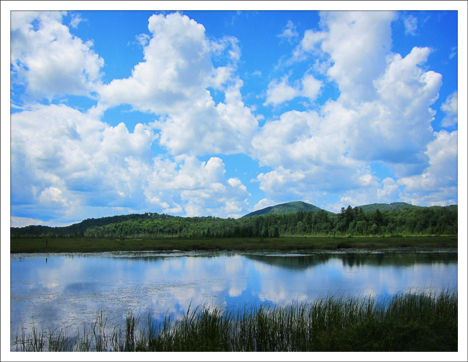 Heron Marsh from the Heron Marsh Trail
overlook (10 July 2012)
Heron Marsh from the Heron Marsh Trail
overlook (10 July 2012)Marshes are the wettest of Adirondack wetlands, varying in depth from a few inches to six feet. A marsh is a mineral-rich wetland where the dominant vegetation consists of herbaceous plants that are rooted in hydric soils, but not in peat. Because marshes are nutrient-rich from the residue of upland drainage and supplied with oxygenated, slowly-moving water, they are highly productive environments, fostering the cycles of growth and decay necessary for plant and animal life. The open areas of Heron Marsh are considered to be marsh and can be observed from the Heron Marsh Trail, Barnum Brook Trail, Bobcat Trail, Woods and Waters Trail (floating bridge), Jenkin's Mountain Trail (overlook), and Logger's Loop Trail (near Shingle Mill Falls). Heron Marsh contains both open water, as well as wet soils that support cattails and reeds.

Heron Marsh represents the interplay of natural and man-made forces. The shallow basin which holds Heron Marsh was created by the last glacier some 12,000 years ago. When the glacier retreated, the shallow depression left over filled with water from the melting ice. In the years prior to 1850, damming of the marsh outlet stream by beavers over millennia produced a nutrient-rich soil on top of the glacial sand plain. Marsh vegetation flourished along the stream banks; and the moist organic soil became home to stands of white cedar. In the 1850s, Levi Rice built a small sawmill dam on the marsh outlet. The resulting reservoir served as the water supply for the Paul Smith's Hotel until the dam was dismantled in 1920. For the next forty years, no dam held back the normal stream flow. Once again, trees took root in the rich soil. Paul Smith's college students rebuilt the dam in 1960, reflooding the land.
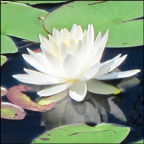 Heron
Marsh contains wetland plants which flourish in the Adirondacks.
These include floating plants, such as Yellow Pond Lily and White
Water-lily. Both of these plants are anchored
to the bottom by roots and have long stalks to leaves that float
on the surface of the water. At lower water depths, emergents
(such as Pickerelweed
and Cattail) flourish. Bladderworts also thrive here; these
are submersed free-floating plants featuring tiny bladders attached
to the leaves, which trap and digest very tiny animals. Blue
Flag Iris also grows in profusion in the shallow water
of the margins of Heron Marsh. Plants which flourish
on the edge of the marsh are related to rhododendrons and include Leatherleaf, Meadow Sweet, Steeplebush, and Sheep
Laurel.
Heron
Marsh contains wetland plants which flourish in the Adirondacks.
These include floating plants, such as Yellow Pond Lily and White
Water-lily. Both of these plants are anchored
to the bottom by roots and have long stalks to leaves that float
on the surface of the water. At lower water depths, emergents
(such as Pickerelweed
and Cattail) flourish. Bladderworts also thrive here; these
are submersed free-floating plants featuring tiny bladders attached
to the leaves, which trap and digest very tiny animals. Blue
Flag Iris also grows in profusion in the shallow water
of the margins of Heron Marsh. Plants which flourish
on the edge of the marsh are related to rhododendrons and include Leatherleaf, Meadow Sweet, Steeplebush, and Sheep
Laurel.
Many species of birds can also be seen or heard around Heron Marsh. Several different species of ducks nest on the marsh, including Ring-necked Duck, American Black Duck, Common Merganser, Wood Duck, and Mallard. Red-winged Blackbirds are commonly seen perching on snags and shrubs on the marsh. Swamp Sparrows nest among the cattails and shrubs along the margins of the marsh. American Bittern often forage for food in the wetland vegetation along the edges of the water. Great Blue Heron can also be seen on edges of the water. The transitional areas around Heron Marsh are home to a wide variety of birds, such as the Common Yellowthroat and the Black-capped Chickadee.
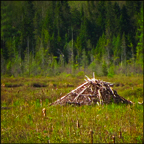 Heron
Marsh also hosts several families of beaver. There are two beaver
lodges on the marsh: one on the north side of the marsh, which
can be observed from the Barnum Brook
Trail overlook; and one on the south side of the marsh, which
can be observed from the Heron Marsh
Trail. Beaver activity is evident all around Heron Marsh.
North American River Otters and muskrats can be seen throughout the year. Otters feed
on the fresh-water mussels and clams in the marsh. The best time to catch
sight of an otter is early morning or late afternoon. On a few
occasions, white tail deer have ventured into the edges of the
marsh. Snapping turtles make their home in the marsh; and painted
turtles are often seen sunning on floating logs in the open water
areas.
Heron
Marsh also hosts several families of beaver. There are two beaver
lodges on the marsh: one on the north side of the marsh, which
can be observed from the Barnum Brook
Trail overlook; and one on the south side of the marsh, which
can be observed from the Heron Marsh
Trail. Beaver activity is evident all around Heron Marsh.
North American River Otters and muskrats can be seen throughout the year. Otters feed
on the fresh-water mussels and clams in the marsh. The best time to catch
sight of an otter is early morning or late afternoon. On a few
occasions, white tail deer have ventured into the edges of the
marsh. Snapping turtles make their home in the marsh; and painted
turtles are often seen sunning on floating logs in the open water
areas.
Bog
A bog is a nutrient-poor acidic wetland dominated by sphagnum mosses, sedges, and shrubs and evergreen trees rooted in deep peat. An example is Barnum Bog, which can be observed from the Boreal Life Trail boardwalk. Some of the margins of Heron Marsh are also considered to be bog.
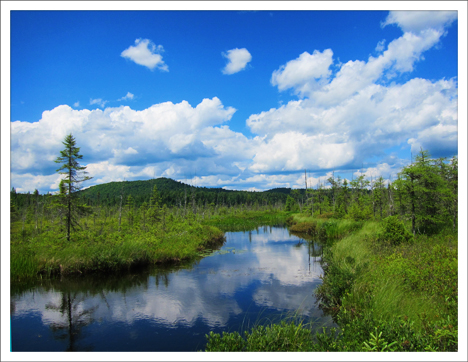 Barnum Bog and Barnum Brook from the Boreal Life Trail (10 July 2012)
Barnum Bog and Barnum Brook from the Boreal Life Trail (10 July 2012)
Some of the wetland-dwelling birds that can be seen on or near Heron Marsh can also be seen or heard on Barnum Bog or in the transitional areas include the Swamp Sparrow, Magnolia Warbler, and the Black-capped Chickadee. Other birds seen or heard on or near the bog include the Yellow-rumped Warbler, Yellow-bellied Flycatcher, Song Sparrow, and White-throated Sparrow. Several species nests in the bog, including the Palm Warbler, which nests in sphagnum moss, and the Lincoln's Sparrow, which nests in shrubs on the bog. The Yellow-bellied Flycatcher also breeds in peat lands. Broad-winged Hawks can often be viewed circling the bog. The Black-backed Woodpecker and the Gray Jay have also been occasionally seen on Barnum Bog or on the edges of the bog.
 Like
other bogs, Barnum Bog has a thick carpet of vegetation consisting
of several layers of sphagnum moss and is very acidic. A
number of insectivorous plants grow on Barnum Bog, including the
Roundleaf Sundew and the Pitcher
Plant. These plants carry
on photosynthesis like other green plants, but supplement their
nutrition by capturing and digesting small insects. The Pitcher
Plant, for instance, has tubular leaves surrounding the base
of the plant. Insects enter the mouth of the plant and are trapped
by the hairs. They then drown in the leaf fluid and are digested
by enzymes and bacteria. The nutrients absorbed from the insects
supplement the nutrients absorbed by the roots. Bladderwort, another
carnivorous plant, can also be found here.
Like
other bogs, Barnum Bog has a thick carpet of vegetation consisting
of several layers of sphagnum moss and is very acidic. A
number of insectivorous plants grow on Barnum Bog, including the
Roundleaf Sundew and the Pitcher
Plant. These plants carry
on photosynthesis like other green plants, but supplement their
nutrition by capturing and digesting small insects. The Pitcher
Plant, for instance, has tubular leaves surrounding the base
of the plant. Insects enter the mouth of the plant and are trapped
by the hairs. They then drown in the leaf fluid and are digested
by enzymes and bacteria. The nutrients absorbed from the insects
supplement the nutrients absorbed by the roots. Bladderwort, another
carnivorous plant, can also be found here.
 Other
plants which thrive on Barnum Bog include Buckbean,
which produces produces
clusters of star-like white flowers in spring and early summer.
This plant, which grows up to about ten inches tall, flourishes
in the wet soil of the bog and can usually be seen blooming
in June. Other wetland plants that flourish on Barnum Bog
include Cotton
Grass and Marsh
Cinquefoil. The latter is
a member of the rose family and produces reddish purple flowers
in late June. Several species of Cotton
Grass grow on Barnum Bog; some bloom in late spring and early
summer, while others bloom in late summer and fall.
Other
plants which thrive on Barnum Bog include Buckbean,
which produces produces
clusters of star-like white flowers in spring and early summer.
This plant, which grows up to about ten inches tall, flourishes
in the wet soil of the bog and can usually be seen blooming
in June. Other wetland plants that flourish on Barnum Bog
include Cotton
Grass and Marsh
Cinquefoil. The latter is
a member of the rose family and produces reddish purple flowers
in late June. Several species of Cotton
Grass grow on Barnum Bog; some bloom in late spring and early
summer, while others bloom in late summer and fall.
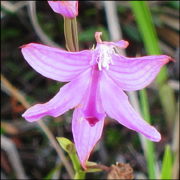 Barnum
Bog also hosts a variety of orchids that thrive in wet soil. These
include Grass
Pink, which gets its name from the
long, narrow, grass-like leaves. The rose-pink or pale
orchid blossoms are sweet-smelling and generally bloom in late
June or early July on Barnum Bog. Another bog-dwelling orchid
-- Rose
Pogonia -- also produces pink flowers and blooms beginning
in late June. The
Latin name "Pogonia" means beard -- a reference
to the bearded lip on the flower. White-fringed Orchids can also be seen blooming on Barnum Bog, usually in late June
or early July.
Barnum
Bog also hosts a variety of orchids that thrive in wet soil. These
include Grass
Pink, which gets its name from the
long, narrow, grass-like leaves. The rose-pink or pale
orchid blossoms are sweet-smelling and generally bloom in late
June or early July on Barnum Bog. Another bog-dwelling orchid
-- Rose
Pogonia -- also produces pink flowers and blooms beginning
in late June. The
Latin name "Pogonia" means beard -- a reference
to the bearded lip on the flower. White-fringed Orchids can also be seen blooming on Barnum Bog, usually in late June
or early July.
 Shrubs
growing on the bog include evergreen members of the heath family,
including Sheep
Laurel, Bog
Laurel, Leatherleaf, Bog Rosemary, and Labrador
Tea. Barnum Bog also hosts a number of small
trees, including Tamaracks and Black Spruce. Tamaracks,
also known as the Eastern Larch or American Larch, are coniferous
trees which turn a golden yellow in fall before shedding their
needles. The trees in the bog, as in other bogs, are small because
the harsh environment causes them to grow very slowly, so a tree
only a few feet high may be quite old.
Shrubs
growing on the bog include evergreen members of the heath family,
including Sheep
Laurel, Bog
Laurel, Leatherleaf, Bog Rosemary, and Labrador
Tea. Barnum Bog also hosts a number of small
trees, including Tamaracks and Black Spruce. Tamaracks,
also known as the Eastern Larch or American Larch, are coniferous
trees which turn a golden yellow in fall before shedding their
needles. The trees in the bog, as in other bogs, are small because
the harsh environment causes them to grow very slowly, so a tree
only a few feet high may be quite old.
Fen
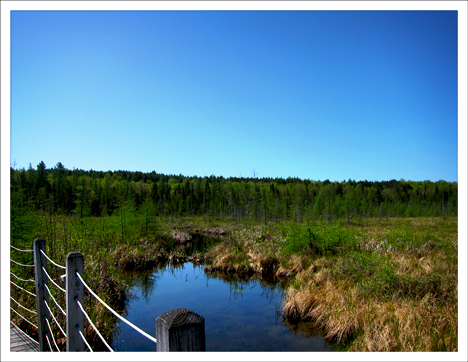 Boardwalk over the fen on the Heron Marsh Trail (19 May 2012)
Boardwalk over the fen on the Heron Marsh Trail (19 May 2012)
A fen is a mineral-rich (alkaline) wetland dominated by sedges and grasses rooted in shallow peat, often with water movement through the peat. The wetland near the boardwalk on the Heron Marsh Trail is considered a fen.
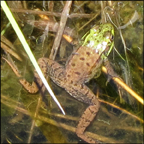 Both
bogs and fens accumulate peat. The feature that distinguishes
fens from bogs is the fact that fens receive water from the surrounding
watershed in inflowing streams and groundwater, while bogs receive
water primarily from precipitation. Fens, therefore, reflect the
chemistry of the geological formations through which these waters
flow. As a result, there is much variation among fens with respect
to acidity and they often do not have the extreme acid conditions
associated with bogs. The plants which grow in a fen tend to be
more varied than those in a bog. In contrast to bogs (where heaths
are more plentiful), fens tend to be dominated by sedges.
Both
bogs and fens accumulate peat. The feature that distinguishes
fens from bogs is the fact that fens receive water from the surrounding
watershed in inflowing streams and groundwater, while bogs receive
water primarily from precipitation. Fens, therefore, reflect the
chemistry of the geological formations through which these waters
flow. As a result, there is much variation among fens with respect
to acidity and they often do not have the extreme acid conditions
associated with bogs. The plants which grow in a fen tend to be
more varied than those in a bog. In contrast to bogs (where heaths
are more plentiful), fens tend to be dominated by sedges.
Swamp
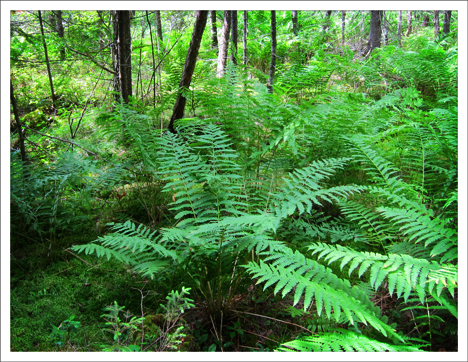 Ferns in swampland near Heron Marsh (10
July 2012)
Ferns in swampland near Heron Marsh (10
July 2012)
A swamp is a freshwater wetland dominated by trees rooted in hydric soils, not in peat. These are areas where woody vegetation grows in soil that, while often waterlogged, is seldom flooded by more than a few inches. Swamps may include either or both hardwood shrubs or trees and conifers. The wooded areas on the margins of Heron Marsh and Barnum Bog are swamps. Ferns and mosses are common in the swampy areas around Heron Marsh and Barnum Bog. These areas also host shade-loving wildflowers, including Common Wood Sorrel and Goldthread. Birds commonly seen or heard in these areas include the Golden-crowned Kinglet, Winter Wren, and Nashville Warbler
References:
Donald D. Cox. A Naturalist's Guide to Wetland Plants. An Ecology for Eastern North America (Syracuse University Press, 2002), pp. 1-11, 64-93.
John Eastman. Swamp and Bog. Trees, Shrubs, and Wildflowers of Eastern Freshwater Wetlands (Stackpole Books, 1995), p. xiv. http://books.google.com/books?id=n7fKt2fdznsC Retrieved 10 July 2012.
Paul A. Keddy. Wetland Ecology. Principles and Conservation (Cambridge University Press, 2010), pp. 17-24. http://www.drpaulkeddy.com/pdffiles/Books/WE%206%20wetland%20types.pdf Retrieved 10 July 2012.
Meiyin Wu and Dennis Kalma. Wetland Plants of the Adirondacks: Herbaceous Plants and Aquatic Plants (Trafford Publishing, 2011). http://books.google.com/books?id=CWUHhAYGPjwC Retrieved 10 July 2012.
USDA Forest Service. Organic Soil Wetlands. http://www.na.fs.fed.us/spfo/pubs/n_resource/wetlands/wetlands9_organic.htm Retrieved 19 July 2012.
